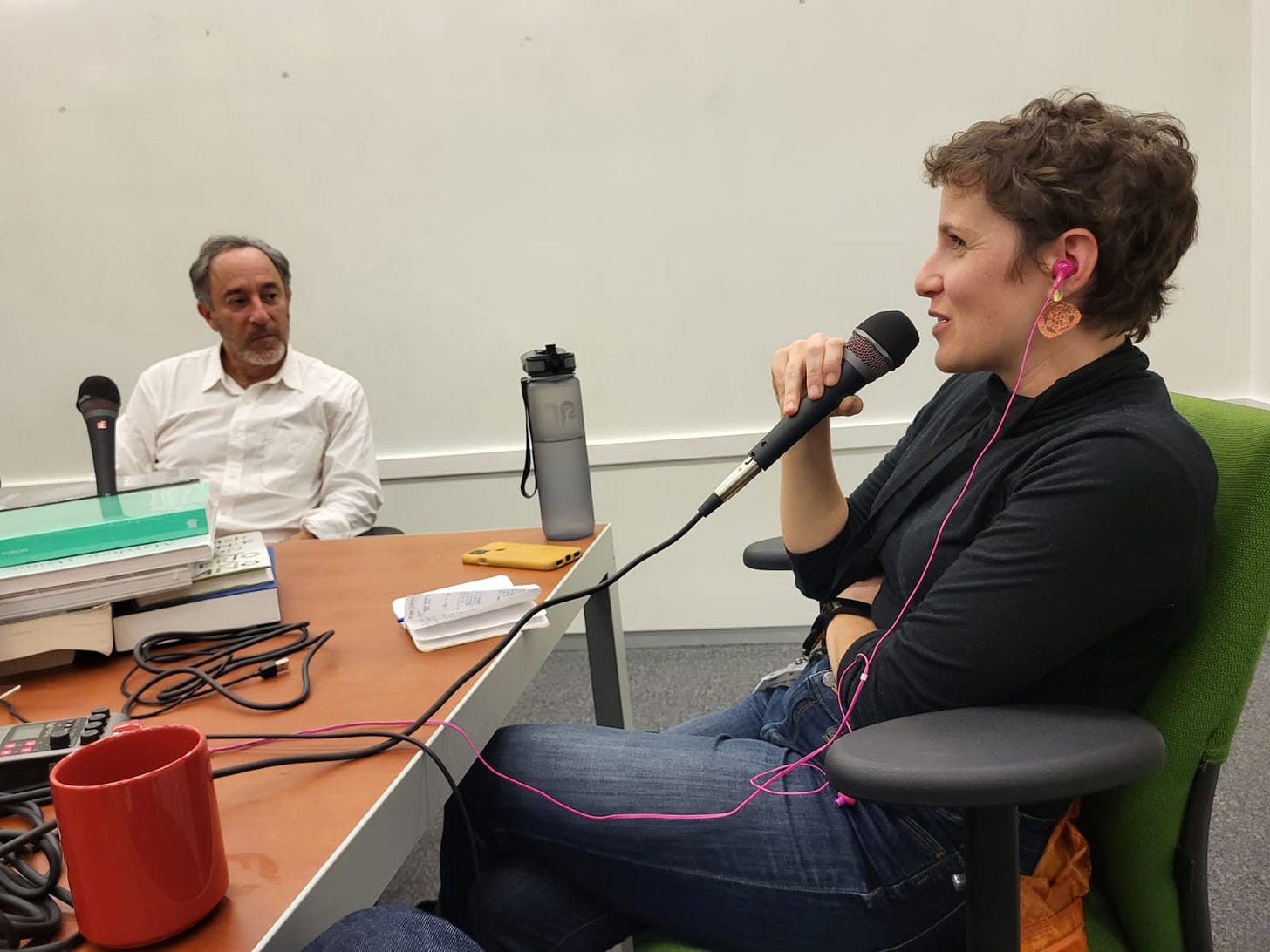Uncertainty #7: Baby, It's Shitty Outside
Exciting pod news! Plus, Vanessa gets lost in the moment, meets her banished self, and opines on some domes.
Happy New Year, good readers of Uncertainty!
Is it a month too late to be wishing you a happy new year? Yes it is! But it’s barely just the year of the Rabbit…so I give myself a pass. Since I last wrote you, I went from sunny Spain to rainy Ireland and back to a dreary, gray New York City, where the natives endure the inhospitable weather huddled within plastic geodesic domes.
A hermetic snow globe of my own — in which to hibernate and hide from humanity — truly sounds like the best way to spend January in New York. But, despite the ambient miserableness of home, I must admit it has been fun getting back into the Uncertain Things swing, including writing this newsletter.
Doom on Zoom
Before we get into the meat of it, special announcement time. 🚨We’re hosting our first ever virtual event!🚨
In a move surprising no one who’s ever listened to us for more than two seconds, the theme is apocalyptic. In Uncertainty #3: Cancel Vultures (written in the wake of our conversation with the doomsayer himself, Peter Turchin), Adaam cited two folks we’ve interviewed who have similarly mused on the reasons for our society’s (impending? current?) collapse: the historian Niall Ferguson and former CIA analyst Martin Gurri. We sent the newsletter to both of them, and asked: hey, would you two want to talk more about this? To each other? In front of a live audience?
Reader, they said yes. And so, on March 7th, at 2pm ET, Adaam and I will venture into a Zoom space for a lively, free, virtual conversation on eschatologies, catastrophes, and general doom. We’ll send out more details in the coming week, but in brief: in order to keep the event intimate and interactive, we’re capping the conversation to only 35 people. If you’re a paid subscriber, you’re in luck. From now until February 14, ONLY paid subscribers can sign up for tickets. We will open up tickets to the general public on February 15. So if you haven’t subscribed yet, now is the time to press the red button.
So button-y. So clickable. Don’t fight the urge. The UX compels you.
Slow Town
One of my highlights from last year was getting to interview The New York Times' architecture critic Michael Kimmelman. When I started out in architecture journalism (back in my ArchDaily days), I greatly looked up to Michael — not just for his impeccable writing skills, but for his laser focus on architecture's greater responsibility: making people's lives better.

When I was reading his latest (unsurprisingly, beautifully-written) book — The Intimate City — in preparation for our conversation, I was struck by this quote from Milan Kundera:
“There is a secret bond between slowness and memory" ... just as there is “between speed and forgetting.”
I speed through my daily life, zipping from meeting to text, flitting from phone call to errand. And I forget, so much. Life blurs by. But when I remember to pause — when I go for a walk, when my husband reminds me to relax and enjoy, when I'm truly present with a good friend — I remember. The present becomes punctuated.
Kimmelman wrote The Intimate City in the pandemic, when the world felt both implausibly still and unbearably frenetic. In it, he walks through New York City neighborhoods with different luminaries, taking the time to experience each place's urban life at a pace where it could be truly observed, appreciated, and, indeed, remembered.

When we experience architecture in an instant, we get a snarky hot take, maybe. If we're lucky, a pretty Instagram post of a beautiful building. But when we slow down, listen and observe, we notice, perhaps, how the light delicately shifts across a building's facade, how its materials are in conversation with the neighborhood around it, how the kids from the school next door take advantage of every nook and cranny of the landscaping when the bell chimes. This is the way that Michael thinks about architecture — as part of a greater context and ecosystem. It's also how he thinks about the great issues challenging our cities, and world today, from homelessness to flooding to infrastructure. It's how I strive to think about my work, too.
And now to something completely different!
Part Time
Just as it’s helpful to think of our buildings as part of an ecosystem, so too can we think about our inner world — a series of inter-working parts in service of a more complicated, greater whole.
I recently came across the theory of Internal Family Systems (IFS) while listening to an episode of We Can Do Hard Things (one of the few podcasts in my constant rotation these days). IFS was formed by psychologist Dick Schwartz; in this YouTube video, Schwartz explains how he got his start as a family systems therapist, and realized that the techniques he had developed to navigate family dynamics could help him guide individuals. Every individual, he posits, is made up of many parts — folks who suffer from multiple personality disorder only differ from the rest of us in terms of the severity of the expression of their parts.
In the video, Schwartz guides listeners through a kind of meditation, inviting them to interrogate a part of themselves they’d like to get to know more. I was listening while cleaning the house, but I dutifully stopped, sat down, broom in hand, to question a part. I chose my disassociative part — the Vanessa who in times of distress vacates the physical realm and goes…elsewhere. In just a few minutes of talking to her (she who floats ethereally along the ceiling, like a young woman in a Chagall painting), I realized, for the first time, that she’s also the Vanessa who is most creative, most magical, most weird…and most banished from my daily life.

Schwartz believes that traumatic events can freeze parts in time: parts that arose to help us survive the trauma and/or its aftermath don’t know how to adapt or change when the trauma is gone. They keep playing their role. The part that, say, self-cuts to help you escape the trauma of an abusive parent, cannot simply be vanquished by sheer will power or discipline — her role must be understood and respected, first.
I’ve only scratched the surface of this theory, but I’m intrigued enough to continue reading/watching more. I’m curious how (if at all) it intersects with cognitive dissonance (somewhere, anywhere, Adaam’s ears are burning), and if it could help us all live easier with our inherent contradictions. And I’m dying to bring back our friend, psychologist Misha Thomas — who you may have heard on our episode Blackness and the Other Side of Trauma (one of my favorites) — to get his professional and personal opinion. To be continued…
Things Worth Your Time ⏰
⏲️ While I was uploading some clips from our back catalog onto TikTok, I recently revisited this gem of a moment from our conversation with Adam Neely, in which he explains how his synesthesia manifests — and gets into the many metaphors we employ to talk about music.
🎧 I recently caught a special episode of Switched on Pop (a collab with the Decoder podcast) all about Taylor Swift and the future of the music industry. It’s a fascinating look into the inanities and instabilities inherent to the industry — a topic we’ll be diving into more, soon.
🎵 I don’t know why, but all month I’ve been turning to/yearning for the subdued vocals, cinematic vibes, and intricate, rhythmic piano lines of Richy Mitch and the Coal Miners. I love them as much as I hate them for being so young. Sigh. A good song to start: “Swiss Woods.”
What We’re Working On ⏭
Adaam and I have interviewed some bad-ass ladies back-to-back this month. Tech is in the middle of the Venn diagram of these three conversations — but we also cover the gurus that seduce us, the journalism that disappoints us, and the cities that break our hearts...stay tuned.
One Last Certain Thing…
Practice Makes Perfect.






